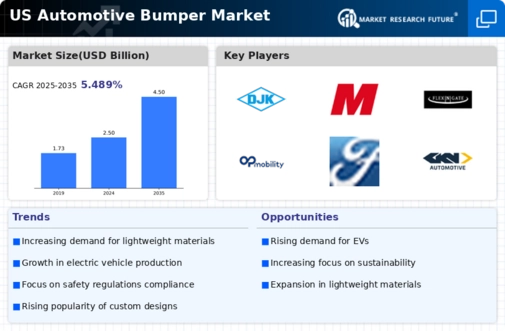The US Automotive Bumper Market is characterized by its dynamic competitive landscape, driven by factors such as innovation, customer preferences, and regulatory demands. As vehicles increasingly become advanced in terms of technology and design, the role of bumpers has evolved beyond mere aesthetics to encompass safety, energy absorption, and functionality. Companies operating in this market are focusing on the development of lightweight materials and enhanced designs that meet stringent safety standards while also appealing to consumer trends for eco-friendliness and sustainability.
Competition is heightened not only among established automotive manufacturers but also from suppliers and aftermarket companies, each striving to differentiate their products through unique value propositions. Strategic partnerships, technological advancements, and market penetration strategies are key elements that define the competition in the US Automotive Bumper Market, as companies seek to enhance their market share and respond effectively to evolving automotive trends.Toyota Motor Corporation holds a significant position in the US Automotive Bumper Market, leveraging its extensive experience and brand reputation to dominate this sector.
The company is recognized for its commitment to quality, safety, and innovation, which translates into the design and manufacturing of bumpers that meet rigorous safety standards while integrating advanced technology features. Toyota's presence in the market is bolstered by its strong research and development capabilities, allowing it to introduce cutting-edge products that cater to consumer demands for durability and aesthetic appeal. The company's strengths lie in its robust supply chain network and strategic collaborations with local suppliers, enabling it to optimize production processes and reduce costs.
Additionally, Toyota's focus on sustainability and recycling initiatives aligns with the growing consumer preference for environmentally-friendly automotive solutions, enhancing its competitiveness in the U.S. market.Daiichi Jitsugyo Co is a notable player in the US Automotive Bumper Market, emphasizing its specialization in producing high-quality bumpers that fulfill the automotive industry's diverse needs. The company's product portfolio includes a range of bumpers designed for various vehicle models, focusing on energy absorption and impact resistance to enhance vehicle safety.
With a strong market presence, Daiichi Jitsugyo Co has established itself through strategic mergers and acquisitions that have bolstered its capabilities and expanded its operational reach within the US. The company's strengths are rooted in its advanced manufacturing technologies and commitment to quality assurance, ensuring that its bumpers meet the highest industry standards. By fostering partnerships with automotive manufacturers, Daiichi Jitsugyo Co continues to innovate and adapt to market changes, positioning itself as a reliable supplier amidst the competitive landscape of automotive components in the US.
The company’s strategies aimed at enhancing customer satisfaction and product development underscore its proactive approach in an evolving market.























Leave a Comment